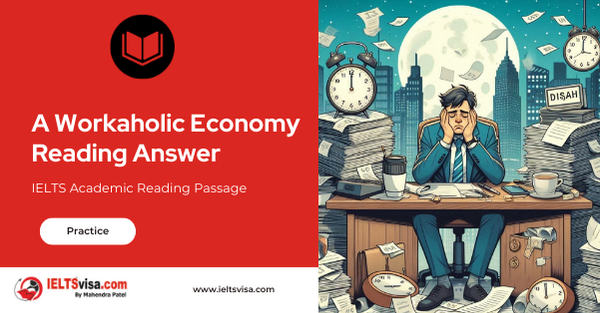A Workaholic Economy Reading Answer
IELTS Academic Reading Passage
FOR THE first century or so of the industrial revolution, increased productivity led to decreases in working hours. Employees who had been putting in 12-hour days, six days a week, found their time on the job shrinking to 10 hours daily, then, finally, to eight hours, five days a week. Only a generation ago social planners worried about what people would do with all this new-found free time. In the US, at least, it seems they need not have bothered.
Although the output per hour of work has more than doubled since 1945, leisure seems reserved largely for the unemployed and underemployed. Those who work full-time spend as much time on the job as they did at the end of World War II. In fact, working hours have increased noticeably since 1970 — perhaps because real wages have stagnated since that year. Bookstores now abound with manuals describing how to manage time and cope with stress.
There are several reasons for lost leisure. Since 1979, companies have responded to improvements in the business climate by having employees work overtime rather than by hiring extra personnel, says economist Juliet B. Schor of Harvard University. Indeed, the current economic recovery has gained a certain amount of notoriety for its “jobless” nature: increased production has been almost entirely decoupled from employment. Some firms are even downsizing as their profits climb. “All things being equal, we”d be better off spreading around the work,’ observes labour economist Ronald G. Ehrenberg of Cornell University.
Yet a host of factors pushes employers to hire fewer workers for more hours and, at the same time, compels workers to spend more time on the job. Most of those incentives involve what Ehrenberg calls the structure of compensation: quirks in the way salaries and benefits are organised that make it more profitable to ask 40 employees to labour an extra hour each than to hire one more worker to do the same 40-hour job.
Professional and managerial employees supply the most obvious lesson along these lines. Once people are on salary, their cost to a firm is the same whether they spend 35 hours a week in the office or 70. Diminishing returns may eventually set in as overworked employees lose efficiency or leave for more arable pastures. But in the short run, the employer’s incentive is clear.
Even hourly employees receive benefits – such as pension contributions and medical insurance – that are not tied to the number of hours they work. Therefore, it is more profitable for employers to work their existing employees harder.
For all that employees complain about long hours, they, too, have reasons not to trade money for leisure. “People who work reduced hours pay a huge penalty in career terms,” Schor maintains. “It”s taken as a negative signal’ about their commitment to the firm.’ [Lotte] Bailyn [of Massachusetts Institute of Technology] adds that many corporate managers find it difficult to measure the contribution of their underlings to a firm’s well- being, so they use the number of hours worked as a proxy for output. “Employees know this,” she says, and they adjust their behavior accordingly.
“Although the image of the good worker is the one whose life belongs to the company,” Bailyn says, “it doesn’t fit the facts.’ She cites both quantitative and qualitative studies that show increased productivity for part-time workers: they make better use of the time they have, and they are less likely to succumb to fatigue in stressful jobs. Companies that employ more workers for less time also gain from the resulting redundancy, she asserts. “The extra people can cover the contingencies that you know are going to happen, such as when crises take people away from the workplace.’ Positive experiences with reduced hours have begun to change the more-is-better culture at some companies, Schor reports.
Larger firms, in particular, appear to be more willing to experiment with flexible working arrangements…
It may take even more than changes in the financial and cultural structures of employment for workers successfully to trade increased productivity and money for leisure time, Schor contends. She says the U.S. market for goods has become skewed by the assumption of full-time, two-career households. Automobile makers no longer manufacture cheap models, and developers do not build the tiny bungalows that served the first postwar generation of home buyers. Not even the humblest household object is made without a microprocessor. As Schor notes, the situation is a curious inversion of the “appropriate technology” vision that designers have had for developing countries: U.S. goods are appropriate only for high incomes and long hours.
Paul Walluh
Questions 1-6
Do the following statements agree with the views of the writer in Reading Passage?
In boxes 1-6 write
YES if the statement agrees with the views of the writer
NO if the statement contradicts the views of the writer
NOT GIVEN if it is impossible to say what the writer thinks about this
| Example | Answer |
| During the industrial revolution people worked harder. | NOT GIVEN |
1. Today, employees are facing a reduction in working hours .
2. Social planners have been consulted about US employment figures.
3. Salaries have not risen significantly since the 1970s.
4. The economic recovery created more jobs.
5. Bailyn’s research shows that part-time employees work more efficiently.
6. Increased leisure time would benefit two-career households.
Questions 7-8
Choose the appropriate letters A-D and write them in boxes 7-8 on your answer sheet.
7. Bailyn argues that it is better for a company to employ more workers because
A it is easy to make excess staff redundant.
B crises occur if you are under-staffed.
C people are available to substitute for absent staff.
D they can project a positive image at work.
8. Schor thinks it will be difficult for workers in the US to reduce their working hours because
A they would not be able to afford cars or homes.
B employers are offering high incomes for long hours.
C the future is dependent on technological advances.
D they do not wish to return to the humble post-war era.
Questions 9-12
The writer mentions a number of factors that have resulted, in employees working longer hours.
Which FOUR of the following factors are mentioned?
Write your answers (A-H) in boxes 9-12 on your answer sheet.
List of Factors
A Books are available to help employees cope with stress.
B Extra work is offered to existing employees.
C Increased production has led to joblessness.
D Benefits and hours spent on the job are not linked.
E Overworked employees require longer to do their work.
F Longer hours indicate greater commitment to the firm.
G Managers estimate staff productivity in terms of hours worked.
H Employees value a career more than a family.
9……………..
10……………..
11……………..
12……………..

Solution:A Workaholic Economy Reading Answer
| 1. NO | 7. C |
| 2. NOT GIVEN | 8. A |
| 3. YES | 9. B/D/F/G |
| 4. NO | 10. B/D/F/G |
| 5. YES | 11. B/D/F/G |
| 6. NOT GIVEN | 12. B/D/F/G |
Review and Practice
- Regularly practice with IELTS reading samples and time yourself to get used to the pressure of the exam.
- Review your mistakes to understand where you went wrong and how to avoid similar errors in the future.
Our Books
Master IELTS Speaking Part 1
IELTS Writing Task 1 Book
IELTS Writing Task 2 Book
A Workaholic Economy Reading Answer Explanation
| Question NO | Question Types | Answer | Keywords | Supporting Sentence | Location of Keywords | Explanations |
|---|---|---|---|---|---|---|
| 1 | Yes/No/Not Given | No | working hours, increased noticeably since 1970 | In fact, working hours have increased noticeably since 1970—perhaps because real wages have stagnated since that year. | Paragraph 2; lines 3-4 | The statement contradicts the writer, as it mentions that working hours have increased despite increased productivity, contradicting the assertion that working hours have not increased. |
| 2 | Yes/No/Not Given | Not Given | – | – | – | The term “social planners” is only briefly mentioned in the opening paragraph, and no further information on their concerns is given. |
| 3 | Yes/No/Not Given | Yes | real wages, stagnated since that year | In fact, working hours have increased noticeably since 1970 — perhaps because real wages have stagnated since that year. | Paragraph 2; lines 4-5 | The writer explicitly states that the increase in working hours is linked to the stagnation of real wages since 1970. |
| 4 | Yes/No/Not Given | No | economic recovery, jobless nature | The current economic recovery has gained a certain amount of notoriety for its “jobless” nature: increased production has been almost entirely decoupled from employment. | Paragraph 3; line 4 | The statement contradicts the writer’s argument that economic recovery has been associated with a “jobless” recovery, where increased production does not correlate with employment gains. |
| 5 | Yes/No/Not Given | Yes | Cites, quantitative, qualitative studies, increased productivity, part-time workers | She cites both quantitative and qualitative studies that show increased productivity for part-time workers: they make better use of the time they have, and they are less likely to succumb to fatigue in stressful jobs. | Paragraph 7; lines 2-3 | The author discusses studies that show how part-time workers are more productive and less likely to suffer from fatigue. |
| 6 | Yes/No/Not Given | Not Given | – | – | – | The term “two-career households” is mentioned in paragraph 9, but it does not relate to the concept of “free time,” so no further information is given. |
| 7 | Choose the appropriate letters | C | extra people, cover the contingencies, going to happen | The extra people can cover the contingencies that you know are going to happen, such as when crises take people away from the workplace. | Paragraph 7; lines 5-6 | The author suggests that additional workers can cover for others who are absent due to crises, making choice C the correct answer. |
| 8 | Choose the appropriate letters | A | U.S. market for goods, skewed, assumption, full-time, two-career households | She says the U.S. market for goods has become skewed by the assumption of full-time, two-career households. | Paragraph 9; lines 3-4 | The author argues that the assumption of full-time, two-career households has distorted the U.S. market for goods, leading to changes in the types of housing and vehicles available. |
| 9 | Choose the appropriate letters | A | U.S. market for goods, skewed, assumption, full-time, two-career households | She says the U.S. market for goods has become skewed by the assumption of full-time, two-career households. | Paragraph 9; lines 3-4 | As in question 8, the author discusses how the assumption of two-career households has skewed the market, impacting housing and automotive industries. |
| 10 | Choose the appropriate letters | B | fewer workers, more hours, spend more time on the job | Yet a host of factors pushes employers to hire fewer workers for more hours and at the same time compels workers to spend more time on the job. | Paragraph 4; lines 1-2 | The writer explains that various factors lead to employers hiring fewer workers but requiring them to work more hours, supporting option B. |
| 11 | Choose the appropriate letters | F | work reduced hours, penalty, career terms, negative signal, commitment, firm | For all that employees complain about long hours, they, too, have reasons not to trade money for leisure. “People who work reduced hours pay a huge penalty in career terms,” Schor maintains. “It’s taken as a negative signal about their commitment to the firm.” | Paragraph 6; lines 2-3 | The author points out that working fewer hours can signal a lack of commitment to a company, thus employees avoid reducing their working hours to avoid career penalties. |
| 12 | Choose the appropriate letters | G | they use, number of hours, proxy for output | – | Paragraph 6; lines 5-6 | The author notes that managers use the number of hours worked as a proxy for output, leading workers to increase their working hours to align with this expectation. |
Practice IELTS Other Modules
IELTS Listening
The IELTS Listening test assesses how well you can understand spoken English in various contexts. It lasts about 30 minutes and is divided into four sections with a total of 40 questions. The listening tasks become increasingly difficult as the test progresses.
IELTS Academic Reading
The IELTS Academic Reading section assesses your ability to understand and interpret a variety of texts in academic settings. It is designed to evaluate a range of reading skills, including skimming for gist, reading for main ideas, reading for detail, understanding inferences, and recognizing a writer's opinions and arguments.
IELTS Speaking
The IELTS Speaking test assesses your ability to communicate in English on everyday topics. It lasts 11-14 minutes and consists of three parts: introduction, cue card, and a discussion based on the cue card topic.
IELTS General Reading
IELTS General Reading tests your ability to understand and interpret various types of texts. Here are some key areas and types of content you can expect to encounter in the reading section, along with tips for effective preparation.
IELTS Academic Writing Task 1
In IELTS Academic Writing Task 1, you are presented with a visual representation of information, such as graphs, charts, tables, or diagrams, and you are required to summarize, compare, or explain the data in your own words.
IELTS General Writing Task 1
In IELTS General Writing Task 1, you are required to write a letter based on a given situation. The letter can be formal, semi-formal, or informal, depending on the prompt. Here’s a breakdown of the key components to include in your letter
IELTS Academic Writing Task 2
In IELTS Academic Writing Task 2, you are required to write an essay in response to a question or topic. Here’s a guide to help you understand the essential elements of this task
IELTS Exam Tips
To succeed in the IELTS exam, practice regularly, familiarize yourself with the test format, improve your vocabulary, develop time management skills, and take mock tests to build confidence.
Grammer for IELTS
Grammar is the foundation of effective communication in English. Understanding tense usage, subject-verb agreement, and sentence structure enhances clarity and coherence in writing and speaking.
Vocabulary for IELTS
Vocabulary plays a crucial role in the IELTS (International English Language Testing System) exam, especially in the Speaking and Writing sections. Here’s an overview of why vocabulary is important and how it impacts your performance
RECENT IELTS SAMPLES QUESTIONS AND ANSWERS
Scientists Are Mapping the World’s Largest Volcano
(A) After 36 days of battling sharks that kept biting their equipment, scientists have...
The Pursuit of Happiness
A In the late 1990s, psychologist Martin Seligman of the University of Pennsylvania urged...
Groucho Marx Arthur Sheekman Reading Answers
In a show-business career that spanned over seventy years, Groucho Marx successfully conquered...
The Fame Machine
Fascination is universal for what Aaron Spelling, a prolific producer of American soap operas,...
The cloud messenger
A. Luke Howard had been speaking for nearly an hour, during which time his audience had found...
The Immunisation Controversy Reading Answers
A. Carl Sagan once said, 'Science loses ground to pseudo-science because the latter seems to...













